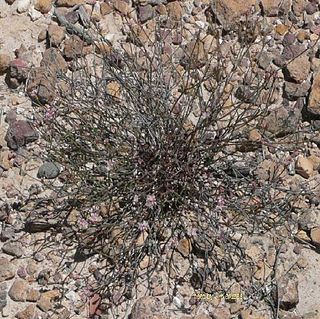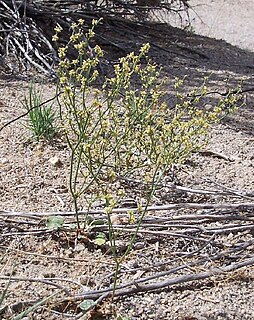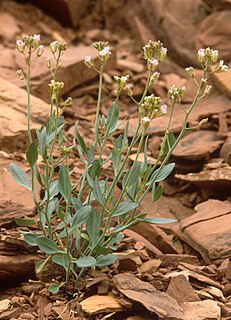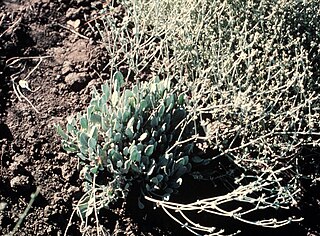
Eriogonum apricum is a rare species of wild buckwheat known by the common name Ione buckwheat. It is endemic to Amador County, California, in the United States.

Eriogonum maculatum is a species of wild buckwheat known by the common name spotted buckwheat. It is native to western North America from Washington to Baja California to Utah, where it can be found in a number of habitats, often in abundance.

Eriogonum ovalifolium is a species of wild buckwheat known by the common name cushion buckwheat. It is native to western North America from California to Alberta, where it is a member of many plant communities in varied habitats, including the sagebrush steppe and alpine regions.

Eriogonum ampullaceum is a species of wild buckwheat known by the common name Mono buckwheat.

Eriogonum butterworthianum is a rare species of wild buckwheat known by the common name Butterworth's buckwheat. It is endemic to the Santa Lucia Mountains of central Monterey County, California, where it is known from a few occurrences in the wilderness southeast of Big Sur in the vicinity of Junipero Serra Peak. Its native habitats include oak and conifer woodlands, chaparral communities, and sandstone outcrops. Eriogonum butterworthianum is a small clumpy shrub or subshrub that grows up to about 30 centimeters tall and wide. Leaves are 2 centimeters long and reddish-green in color. They are woolly, oval in shape, and curled under at the edges. The inflorescence is a cluster of flowers up to 2 or 3 centimeters wide. Each individual flower is a few millimeters wide and dull yellowish to pinkish in color. Flowers bloom June to September.

Eriogonum callistum is a rare species of wild buckwheat, known by the common name Tehachapi buckwheat.
Eriogonum evanidum is a rare species of wild buckwheat known by the common name vanishing wild buckwheat. It is native to southern California and Baja California, where it has been collected from widely scattered areas. Most historical occurrences are now extirpated. Some sources suggested that it was probably extinct, but living specimens were rediscovered in 2007.

Eriogonum spectabile is a rare species of wild buckwheat known by the common name Barron's buckwheat. It is endemic to Plumas County, California, where it is known from two occurrences in Lassen National Forest near Chester. There are approximately 250 individuals in existence. It grows in scrubby, forested mountain habitat, only on glaciated andesite substrates. This rare plant was discovered in 1997 and described to science as a new species in 2001.

Eriogonum gypsophilum is a rare species of wild buckwheat known by the common names Seven River Hills buckwheat and gypsum wild buckwheat. It is endemic to the state of New Mexico in the United States, where it is known from only three sites in Eddy County. It is limited to a specific type of soil which is high in gypsum. The plant has been federally listed as a threatened species of the United States since 1981.

Pediocactus despainii is a rare species of cactus known by the common names Despain's cactus and San Rafael cactus. It is endemic to the state of Utah in the United States, where it is limited to the San Rafael Swell in Emery County, Utah.

Schoenocrambe argillacea is a rare species of flowering plant in the mustard family known by the common names clay reed-mustard, Uinta Basin plainsmustard, and clay thelypody.

Schoenocrambe barnebyi is a rare species of flowering plant in the mustard family known by the common names Barneby reed-mustard, Syes Butte plainsmustard, and Barneby thelypody. It is endemic to Utah in the United States, where it is known only from Emery and Wayne Counties. It is threatened by habitat degradation and destruction. It is federally listed as an endangered species of the United States.

Astragalus montii is a rare species of flowering plant in the legume family known by the common name heliotrope milkvetch. It is endemic to Utah in the United States, where there are only three known populations. It is a federally listed threatened species of the United States. This species is often treated as a variety of Astragalus limnocharis.
Eriogonum codium is a species of wild buckwheat known by the common names basalt desert buckwheat and Umtanum Desert wild buckwheat. It is endemic to Washington in the United States, where it is known only from Hanford Reach National Monument in Benton County. It was discovered in 1995 during an inventory of the biodiversity of the monument and described to science in 1997.
Eriogonum visheri is a species of wild buckwheat known by the common names Dakota wild buckwheat and Visher's buckwheat. It is native to the Great Plains in the United States, where it is known from North Dakota, South Dakota, and Montana.

Eriogonum niveum is a species of flowering plant in the buckwheat family known by the common name snow buckwheat. It is native to the Pacific Northwest of North America, where it occurs in British Columbia, Washington, Oregon, and Idaho. It flowers late in the summer.
Eriogonum brandegeei is a species of flowering plant in the buckwheat family known by the common name Brandegee's buckwheat. It is endemic to Colorado in the United States, where it occurs in Fremont and Chaffee Counties.
Eriogonum coloradense is a species of flowering plant in the buckwheat family known by the common name Colorado buckwheat. It is endemic to Colorado in the United States.

Trifolium friscanum is a rare species of flowering plant in the legume family known by the common name Frisco clover. It is endemic to the US state of Utah, where it is known only from Beaver and Millard Counties. It is found growing on the San Francisco Mountains, Beaver Lake Mountains, Wah Wah Mountains and Tunnel Springs Mountains. Most individuals live in the San Francisco Mountains, where the highest point is called Frisco Peak. It was originally described as a variety of Trifolium andersonii in 1978, but was elevated to species status in 1993. It occurs over 250 km (160 mi) away from the nearest T. andersonii.

Physaria tumulosa is a rare species of flowering plant in the family Brassicaceae known by the common name Kodachrome bladderpod. It is endemic to Utah in the United States, where it is known only from Kane County. There is only one known population of this plant made up of scattered occurrences totalling about 20,000 individuals, all within the Kodachrome Basin. The plant is threatened by the loss and degradation of its habitat. It is federally listed as an endangered species. It was previously treated as a subspecies of Physaria hitchcockii.
















